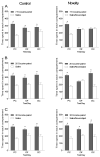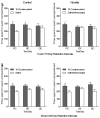Competition between novelty and cocaine conditioned reward is sensitive to drug dose and retention interval
- PMID: 20141289
- PMCID: PMC2824887
- DOI: 10.1037/a0018226
Competition between novelty and cocaine conditioned reward is sensitive to drug dose and retention interval
Abstract
The conditioned rewarding effects of novelty compete with those of cocaine for control over choice behavior using a place conditioning task. The purpose of the present study was to use multiple doses of cocaine to determine the extent of this competition and to determine whether novelty's impact on cocaine reward was maintained over an abstinence period. In Experiment 1, rats were conditioned with cocaine (7.5, 20, or 30 mg/kg ip) to prefer one side of an unbiased place conditioning apparatus relative to the other. In a subsequent phase, all rats received alternating daily confinements to the previously cocaine paired and unpaired sides of the apparatus. During this phase, half the rats had access to a novel object on their initially unpaired side; the remaining rats did not receive objects. The ability of novelty to compete with cocaine in a drug free and cocaine challenge test was sensitive to cocaine dose. In Experiment 2, a place preference was established with 10 mg/kg cocaine and testing occurred after 1, 14, or 28 day retention intervals. Findings indicate that choice behaviors mediated by cocaine conditioning are reduced with the passing of time. Taken together, competition between cocaine and novelty conditioned rewards are sensitive to drug dose and retention interval.
(c) 2009 APA, all rights reserved.
Figures






Similar articles
-
Competition between the conditioned rewarding effects of cocaine and novelty.Behav Neurosci. 2008 Feb;122(1):140-50. doi: 10.1037/0735-7044.122.1.140. Behav Neurosci. 2008. PMID: 18298257
-
Music-induced context preference following cocaine conditioning in rats.Behav Neurosci. 2011 Aug;125(4):674-80. doi: 10.1037/a0024341. Behav Neurosci. 2011. PMID: 21688895 Free PMC article.
-
Conditioned object preference: an alternative approach to measuring reward learning in rats.Learn Mem. 2016 Oct 17;23(11):623-630. doi: 10.1101/lm.042598.116. Print 2016 Nov. Learn Mem. 2016. PMID: 27918282 Free PMC article.
-
Prior extended daily access to cocaine elevates the reward threshold in a conditioned place preference test.Addict Biol. 2014 Sep;19(5):826-37. doi: 10.1111/adb.12053. Epub 2013 May 1. Addict Biol. 2014. PMID: 23634951 Free PMC article.
-
Chronic exercise increases sensitivity to the conditioned rewarding effects of cocaine.Pharmacol Rep. 2008 Jul-Aug;60(4):561-5. Pharmacol Rep. 2008. PMID: 18799826 Free PMC article.
Cited by
-
Environmental enrichment protects against the acquisition of cocaine self-administration in adult male rats, but does not eliminate avoidance of a drug-associated saccharin cue.Behav Pharmacol. 2012 Feb;23(1):43-53. doi: 10.1097/FBP.0b013e32834eb060. Behav Pharmacol. 2012. PMID: 22157144 Free PMC article.
-
Perirhinal Cortex mGlu5 Receptor Activation Reduces Relapse to Methamphetamine Seeking by Restoring Novelty Salience.Neuropsychopharmacology. 2016 May;41(6):1477-85. doi: 10.1038/npp.2015.283. Epub 2015 Sep 14. Neuropsychopharmacology. 2016. PMID: 26365953 Free PMC article.
-
A Possible Role of Anhedonia as Common Substrate for Depression and Anxiety.Depress Res Treat. 2016;2016:1598130. doi: 10.1155/2016/1598130. Epub 2016 Mar 2. Depress Res Treat. 2016. PMID: 27042346 Free PMC article. Review.
-
Complex Interactions Between Sex and Stress on Heroin Seeking.Front Neurosci. 2021 Dec 10;15:784365. doi: 10.3389/fnins.2021.784365. eCollection 2021. Front Neurosci. 2021. PMID: 34955731 Free PMC article.
-
Reference place conditioning procedure with cocaine: increased sensitivity for measuring associatively motivated choice behavior in rats.Behav Pharmacol. 2010 Jul;21(4):323-31. doi: 10.1097/FBP.0b013e32833b110b. Behav Pharmacol. 2010. PMID: 20505511 Free PMC article.
References
-
- Bardo MT, Bevins RA. Conditioned place preference: what does it add to our preclinical understanding of drug reward? Psychopharmacology. 2000;153(1):31–43. - PubMed
-
- Bardo MT, Donohew RL, Harrington NG. Psychobiology of novelty seeking and drug seeking behavior. Behavioural Brain Research. 1996;77:23–43. - PubMed
-
- Bardo MT, Dwoskin LP. Biological connection between novelty- and drug-seeking motivational systems. In: Bevins RA, Bardo MT, editors. Nebraska symposium on motivation: Vol 50 Motivational factors in the etiology of drug abuse. Lincoln, NE: University of Nebraska Press; 2004. pp. 127–158. - PubMed
-
- Bardo MT, Rowlett JT, Harris MJ. Conditioned place preference using opiate and stimulant drugs: A meta-analysis. Neuroscience and Biobehavioral Reviews. 1995;19:39–51. - PubMed
-
- Barr GA, Paredes W, Bridger WH. Place conditioning with morphine and phencyclidine: Dose dependent effects. Life Sciences. 1985;36(4):363–368. - PubMed

